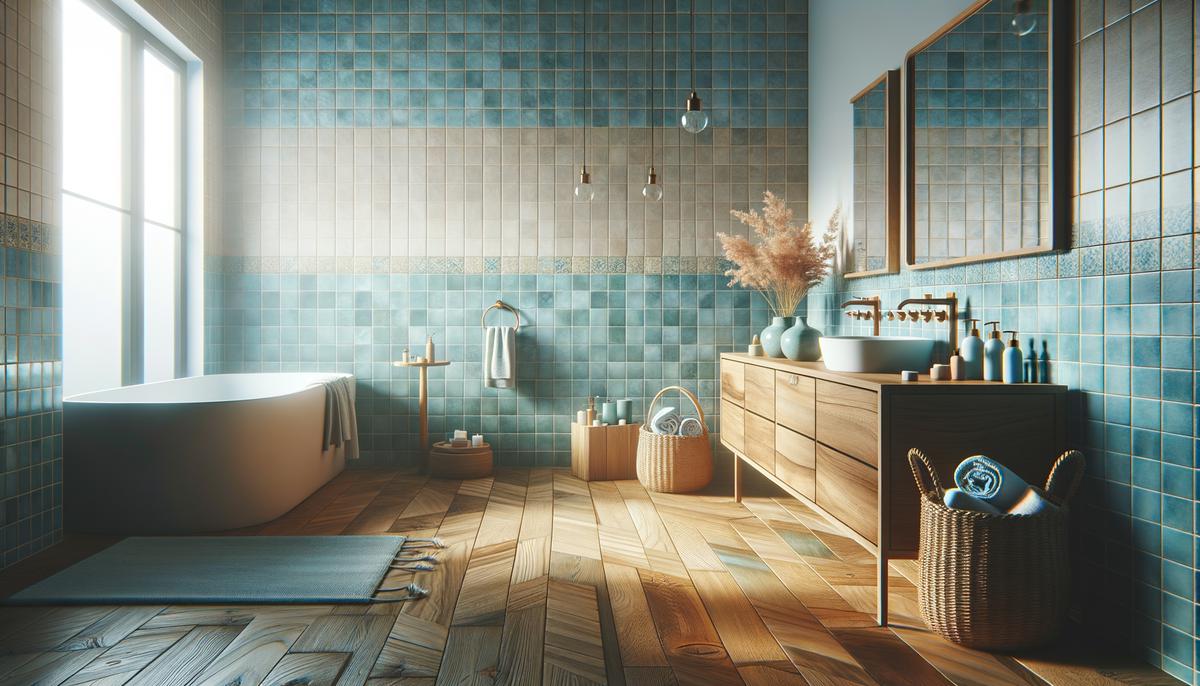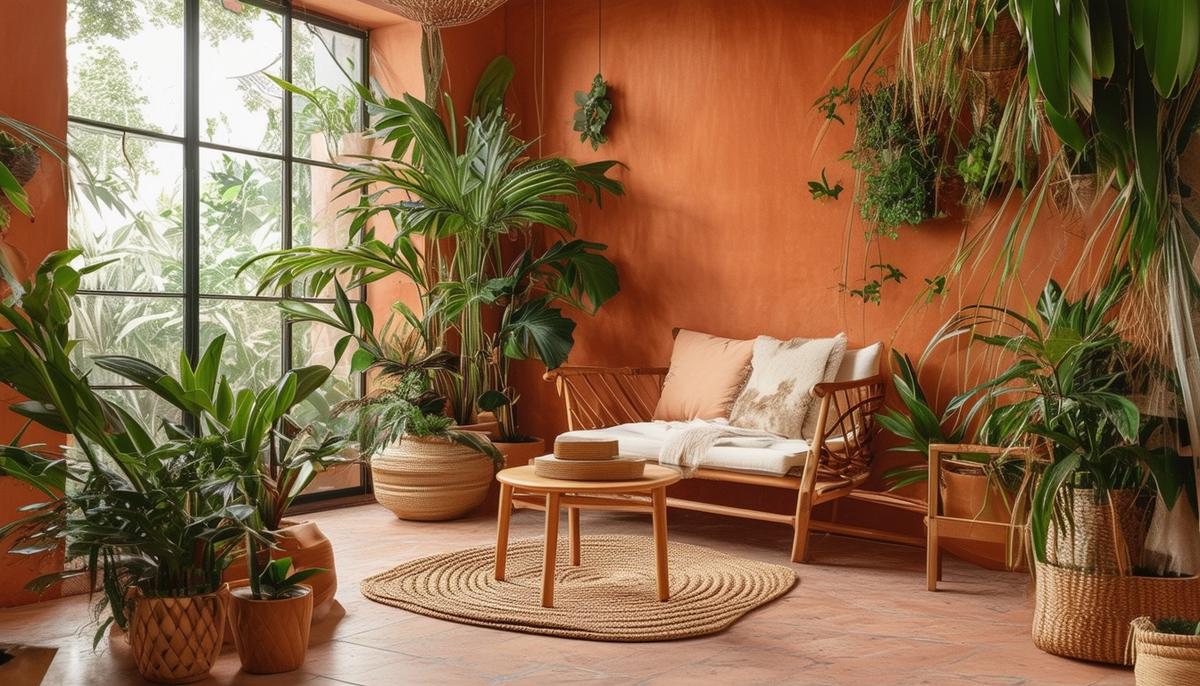Choosing the right colors for your home can significantly impact its ambiance and your mood. Let's take a closer look at how warm colors like red, orange, and yellow can energize your space while cool tones such as blue, green, and purple bring tranquility. Additionally, we'll explore the timeless appeal of neutral shades like gray, beige, and white as well as the grounding effect of earth tones.
Warm Colors: Red, Orange, Yellow
Red, orange, and yellow are warm colors that can transform a room, offering energy, cheer, and a cozier atmosphere. Knowing where and how to use them is crucial to ensuring your home doesn't feel overwhelming.
Red is bold and commands attention. Using red in social areas like living rooms or dining rooms can infuse a space with energy and passion. Balance it out with neutral tones like white or beige, using red sparingly through accents like throw pillows or rugs.
Orange is cheerful and inviting, making it perfect for spaces where you want to foster conversation and joy, like kitchens and breakfast nooks. Think an orange backsplash or barstools. But as with any strong color, moderation is key. Pair orange with calm colors like off-white or soft grey to prevent it from becoming too intense.
Yellow is bright, optimistic, and makes any space feel warm and welcoming. It's perfect for kitchens, hallways, or bathrooms where natural light might be lacking. Subdued shades like a yellow accent wall or cabinets work wonders without being overwhelming.
Using red, orange, and yellow as accent colors adds warmth and character without overwhelming a space. Layering these colors with neutrals or cooler tones can help strike the right balance.

Cool Colors: Blue, Green, Purple
Cool colors like blue, green, and purple evoke calm, tranquility, and relaxation, making them perfect for spaces where you want to unwind and feel at ease.
Blue is the quintessential color of calm, inspiring peace and serenity. It's a fantastic choice for bedrooms and bathrooms, where relaxation is key. Soft shades like a light blue bedroom or bathroom tiling can create a serene, spa-like feel.
Green is like a breath of fresh air, invoking feelings of growth, renewal, and harmony. It's effective in places meant for relaxation, such as living rooms, bedrooms, and home offices. Combine gentle greens with natural materials like wooden furniture and houseplants for a calming, grounded space.
Soft lilac or lavender can transform a bedroom or reading nook into a peaceful retreat. These hues add a touch of whimsy while remaining calming. In living areas, light purples add a sense of sophisticated tranquility.
To amplify the calming nature of cool colors, integrate natural elements like wood, soft fabrics, and plenty of greenery. Lighting also plays a crucial role; opt for warm bulbs and lamps to create a gentle, soothing ambiance.

Neutral Colors: Gray, Beige, White
Gray, beige, and white are versatile neutral colors that offer a timeless foundation for any style. They provide balance and sophistication, allowing other colors and design elements to shine.
Gray is adaptable, ranging from soft hues to deep charcoals. It's an excellent backdrop for vibrant artwork or textiles while combining with metallics like gold or silver for glamour. Different shades of gray within a space create depth and interest.
Beige is a warm neutral that brings coziness and understated elegance. It's perfect for creating a grounded, welcoming atmosphere. Combine beige with other neutrals or earthy tones like terracotta and olive green for warmth and comfort.
White is the ultimate neutral canvas that can open up and brighten any space. It's perfect for showcasing bold decor choices while allowing you to experiment with color. White finishes offer a range of looks, from sleek and modern to classic and serene.
The magic lies in layering neutrals, creating a nuanced and rich aesthetic. Combining shades of gray, beige, and white in a single room adds texture and depth while remaining cohesive.
Enhance neutral spaces with a variety of materials and finishes, mixing matte and glossy surfaces, soft fabrics, and natural elements like wood and stone. Lighting also plays a crucial role in bringing out the best in neutrals.

Earth Tones and Their Connection to Nature
Earth tones like terracotta, sienna, and olive green embody a natural warmth that connects your living space to the outdoors. These hues are the ultimate way to bring an earthy, grounded feel to your home, creating cozy and inviting environments.
Terracotta
Terracotta is the warm, reddish-brown tone reminiscent of baked clay and sun-drenched landscapes. When utilized in home decor, this hue brings a natural and welcoming ambiance to any space. Its warmth can envelop a room in a comforting embrace, making it perfect for creating a cozy atmosphere. Imagine a living room with terracotta-colored walls, complemented by natural wooden furniture and soft, cream textiles. The space immediately feels warmer and more inviting.
The psychological impact of terracotta is profound. It's a color that evokes feelings of earthiness and stability, grounding the mind and body. This makes it ideal for areas where you seek relaxation and comfort, like the living room or a reading nook. Additionally, terracotta pairs beautifully with other natural elements like stone, ceramics, and woven fabrics, enhancing its nature-inspired charm. To keep the look balanced, consider using terracotta as an accent color in furniture pieces like ottomans or side tables, or in accessories like vases and throw blankets.
Sienna
Sienna is a rich, reddish-brown hue that feels both luxurious and grounded. It can add a touch of rustic elegance to your home, making it suitable for spaces where you want to incorporate a warm, classic aesthetic. Picture a sienna-colored velvet sofa against a backdrop of soft beige walls; it exudes a sophisticated yet inviting feel. This color is perfect for creating a focal point in a room, drawing the eye and inviting people to sit and stay.
Psychologically, sienna is associated with warmth, security, and comfort. It brings to mind the deep hues of autumn leaves and the rich earth, instilling a sense of timelessness. Sienna works wonderfully in communal spaces like dining rooms or family rooms, where it can enhance conversations and foster a sense of togetherness. Pairing sienna with other warm colors like mustard yellow or deep orange can create a cohesive, autumnal palette that feels snug and welcoming.
Olive Green
Olive green is the quintessential earth tone that connects your indoor environment directly with nature. This muted, slightly grayish-green hue is reminiscent of lush foliage and serene landscapes, making it an incredibly calming and restorative color. It brings a sense of tranquility to any space, making it ideal for bedrooms, bathrooms, or home offices. Imagine an olive green accent wall in your bedroom, paired with crisp white linens and natural wooden furniture. It creates a haven of peace and relaxation.
From a psychological perspective, olive green promotes feelings of harmony and balance. It's associated with nature and renewal, making it a great choice for spaces where you want to unwind and rejuvenate. Incorporating olive green in your decor can be as simple as adding a few potted plants, using green-hued textiles, or even painting a piece of furniture. To enhance its natural vibe, combine olive green with other earth tones like tan, terracotta, or sienna, creating a cohesive, grounded palette.
Creating a Cohesive Earthy Environment
When using earth tones in your home decor, the key is to balance them with other natural materials and elements. This reinforces the connection to nature and enhances the cozy, inviting atmosphere. Consider incorporating:
- Wooden furniture
- Wicker baskets
- Stone accessories
- Plenty of greenery
These elements complement the earthy tones beautifully, creating a harmonious and organic look.
Layering textures is another effective way to enhance the impact of earth tones. Mixing and layering different textures — from soft fabrics to rougher, natural ones — adds depth and interest to your space.
Lighting also plays a crucial role in bringing out the warmth and coziness of earth tones. Soft, ambient lighting such as warm white bulbs, candles, or even fairy lights can amplify the natural glow of these colors, making your home feel like a snug retreat. Natural light is even better, so keep your windows open and let the daylight flood in.
Adding small accent pieces in complementary colors can create a dynamic and visually interesting space. Think about using deep blues, soft corals, or even mustard yellows to add pops of color that still harmonize with your overall earthy theme.
Earth tones like terracotta, sienna, and olive green have the power to transform your home into a cozy, inviting space that feels closely connected to nature. By thoughtfully incorporating these hues into your decor, you create an environment that not only looks beautiful but also nurtures a sense of comfort and well-being.

Leave a Reply